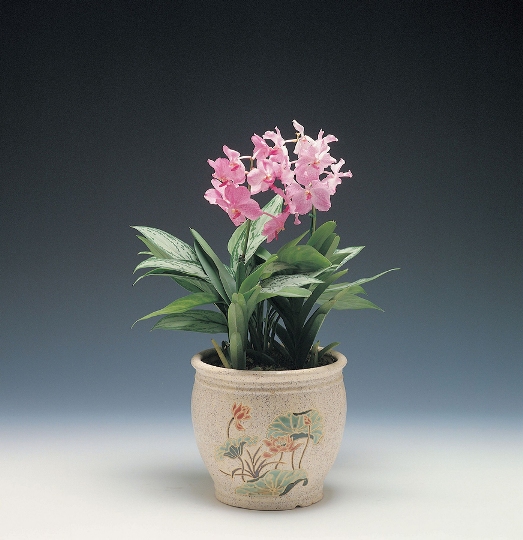
When you are looking to pot orchids a few factors when taken into consideration go a long way to define healthy growth of your orchids. Therefore you must:
- Select the proper type of pots
- Choose a good potting mix to use.
- Know how much drainage is needed for that particular orchid type.
Before you begin to pot your orchids, it is essential to determine which type of pots you want to use. The most commonly used pots for planting orchids are made of clear plastic. It allows light to reach the roots as well as lets you monitor the growth of the roots. For certain types of orchids, net pots and wooden pots are also used as they both allow great drainage and ample room for root growth.
Orchids need to be repotted frequently as well. Different types of orchids require repotting at different intervals, some need to be repotted every year, whereas some kinds can do as long as three years between repotting.
The Most Commonly Found Orchids
Dendrobium
These orchids should be potted in small plastic pots as they have very fine roots and like to be tightly potted. Dendrobiums usually grow much taller than the pot and need to be repotted annually to maintain their healthy growth. These orchids do not need to be watered very frequently; twice a week is usually enough and they need very good drainage after watering. So ensure that there is no excess water remaining in the pot. It is important to use a good medium and generally a classic dendrobium orchid mix is made up of:
- Pea Gravel
- Small and Medium Coconut Husk Chips
- Perlite
- Small Granite Chips
- Small Lava Rocks
Cymbidium
These orchids are potted in slightly larger clear plastic pots to monitor the water content as well as let in good amounts of light. In order to provide adequate drainage to cymbidiums, the drainage hole in the pot is usually enlarged to almost three times its original size. They are repotted when the pseudo-bulbs begin to bulge against the sides of the pot, usually 3 years. Normally a cymbidium orchid mix is slightly acidic and also provides good drainage for the plant. It is usually made up of:
- Fir Bark
- Chopped Redwood
- Rice Hulls
- Coir
- Perlite
Oncidium
This is the most diverse category of orchids as they are found in a large number of environments. That is why you need to determine the specific requirements of the oncidium orchid type you want to pot. The potting medium must be well drained as when water is left in for too long, it causes fungal infections and roots to rot. Commonly oncidium potting mixes consist of materials which dry up quickly such as:
- Small Coconut Husk Chips
- Rice Hulls
- Small Granite Chips
- Small Sponge Rocks
- Hardwood Charcoal Chunks
- Coarse Fir Bark
Vanda
This is a unique type of orchid which is grown in baskets as it allows the long roots to hang out of the basket. They require a lot of humidity and moisture to grow and that is why a potting mix blend has to include:
- Tree Fern
- Fir Bark
- Charcoal
- Coconut Husk Fiber
Paphiopedilum
These orchids can be easily grown at home by placing them under lights and in clear plastic pots to allow the light to penetrate. These orchids require a potting mix with high moisture retention but excellent drainage. That is why the normal paphiopedilum orchid mix is comprised of:
- Coarse Fir Bark
- Perlite
- Coarse Sand
- Sphagnum Moss
Phalaenopsis
The best way to pot phalaenopsis is in clear plastic pots with many drainage holes to prevent root decay. The potting mix needs to be very porous as well and phalaenopsis orchids usually don’t need repotting for about 2 years. The potting mix mainly consists of:
- Sphagnum Moss
- Medium Perlite
- Granite Chips
The final thing you need to keep in mind is to provide the necessary nutrients for growth to your orchids. Look for a balanced orchid fertilizer which contains equal parts of nitrogen, phosphorus and potassium plus micro-nutrients. Buy a liquid fertilizer which has 10-10-10 or 20-20-20 on the label and apply if after watering the orchids for optimal growth.
If the orchid fertilizing product you are using says to apply it once a week, water the substance down by 50 percent. Also, about one time per month, water the orchids without any orchid fertilizer to clean out any built up minerals and residue.
Mary Ann Berdak is the publisher of OrchidCareZone.com an online destination for orchid growing tips and advice. For more information on caring for your newly purchased plants, download her free report, “The 5 Biggest Orchid Mistakes (and How to Avoid Them!)”, at OrchidSecretsRevealed.com.
Related Articles & Free Email Newsletter
Inaccurate Objections to Semi-Hydroponics Culture
Light Reflections & Reflectors for Orchids



Comment here